After a hard winter, there’s nothing like seeing the first signs of bulb flowers sprouting from the earth.
It’s as if they are there to let us know that winter is well and truly behind us.
In early spring, bulbs like daffodils, snowdrops, and tulips offer a lovely display as they dance in the breeze.
Whether planted in pots or as borders, these garden plants are among the simplest and most satisfying to grow.

Bulbs will brighten up any garden.
Tulips, for example, come in many vibrant colors, from purples and reds to white, pink, and yellow. They are a fabulous contrast to the typical subdued colors of other plants at that time of the year.
From spring through fall, bulbs are beloved by gardeners everywhere.
In this article, you will discover the different types of bulbs, when you should plant them, and the varieties of flowers they produce.
Keep reading as we explore the wonderful world of bulbs.
Table of Contents
What Is a Bulb?
A bulb is an underground structure that holds the nutrients for the plant’s entire life cycle.
There are five different types of bulb structures: true bulbs, corms, tubers, tuberous roots, and rhizomes.
The main job of these underground storage structures is to store food reserves for the plants so that they can stay alive.
Most bulbs are perennials that grow and bloom for some time or a season. At the end of each growing season, they go to sleep for a while and die back to ground level.
The growing season for spring bulbs ends in late spring or early summer.
Bulbs that bloom in the spring start to regrow in the fall, and their cycle begins the following spring again.
What Types of Bulbs Are There?
True Bulbs
True bulbs can be split up into two categories: tunicate or imbricate.
The paper–like tunic of a tunicate bulb shields the scales from drying and mechanical damage.
Tulips, daffodils, hyacinths, and alliums are fine examples of tunicate bulbs.
Plants like daffodils create new bulbs around the original bulb, known as offsets. They grow from mother bulb buds and form new plants.
If overcrowding happens when new bulbs are formed, it’s time to dig them up and separate them. Smaller than usual flowering is an indication of bulb overcrowding.
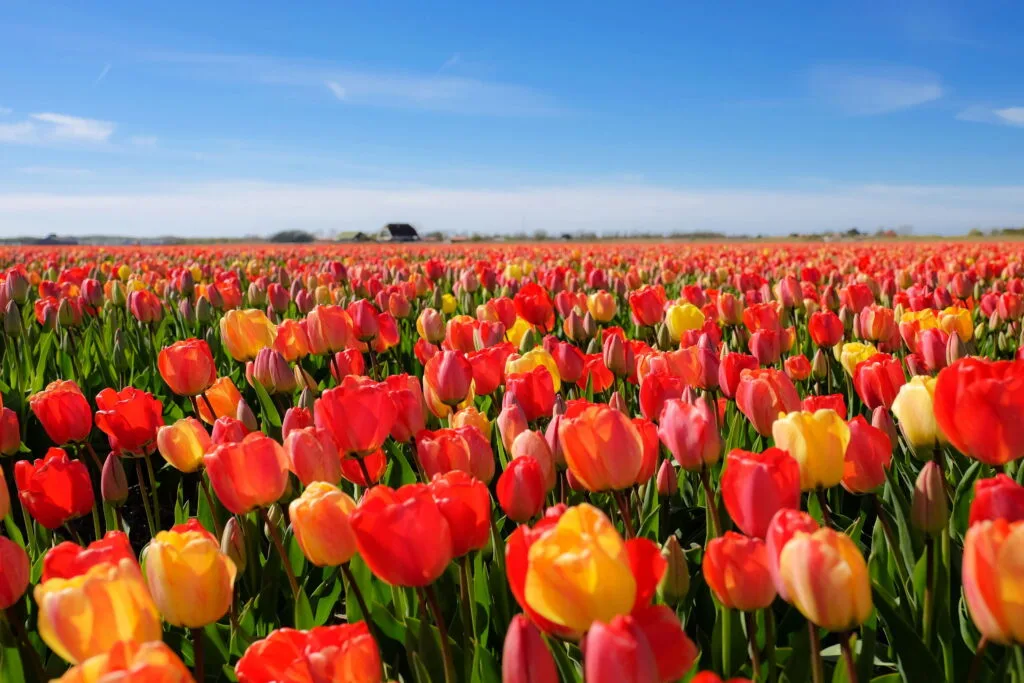
Lilies are imbricate bulbs.
The fleshy scales are unprotected in the imbricate bulb. They do not have a protective layer like the tunicate bulbs.
Before planting, imbricate bulbs must be kept moist to avoid scale damage.
Corms
A corm is a modified stem base that has expanded into a mass of tissue for storage.
When a corm is split in half, there are no apparent storage rings, which is the main difference between corms and true bulbs.
The corm comprises a basal plate, a thin tunic, and a point from where growth begins.
Gladiolus, crocus, and autumn crocus are examples of plants that grow from corms.
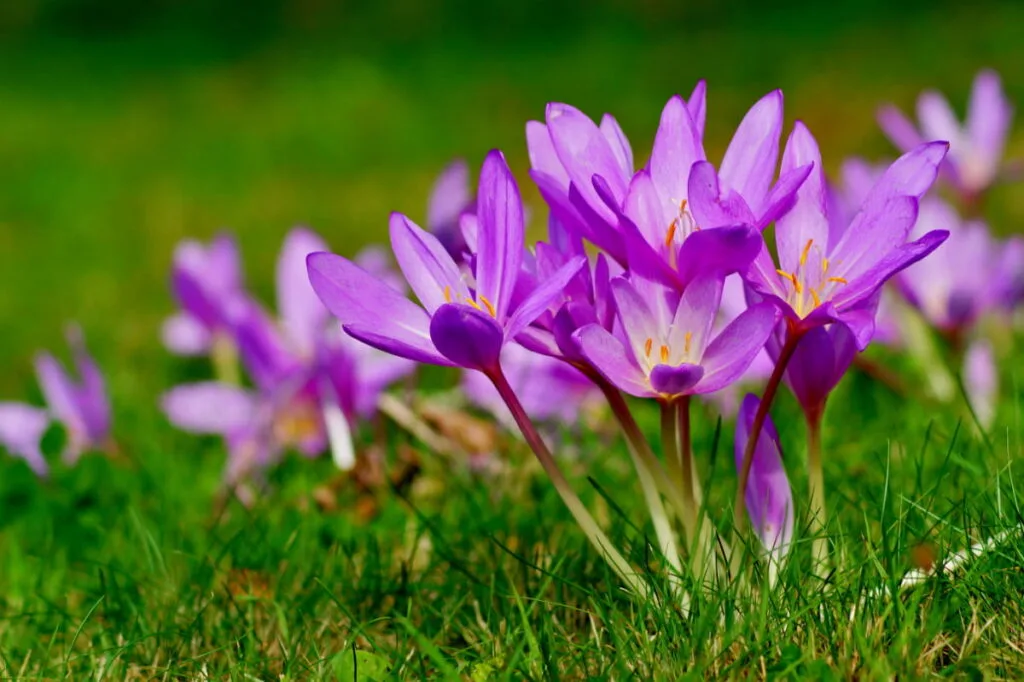
When digging gladiolus corms in the fall, they should be sorted between well–developed corms to be preserved for replanting and poorly grown corms to be discarded.
The freshly excavated corms will have pea–sized cormels developed around the top. The old corm’s remnants will be underneath the freshly developed cormels.
The corm’s growth point will be visible after cleaning it up and removing the old stem.
Cormels may be stored and replanted until they bloom.
Tubers
Unlike true bulbs and corms, tubers have no base plate from which roots sprout and no protective tunic covering.
The caladium tuber has buds all over its surface. Roots and shoots grow from these buds.
Caladiums, oxalis, anemones, and potatoes are plants that grow from tubers.
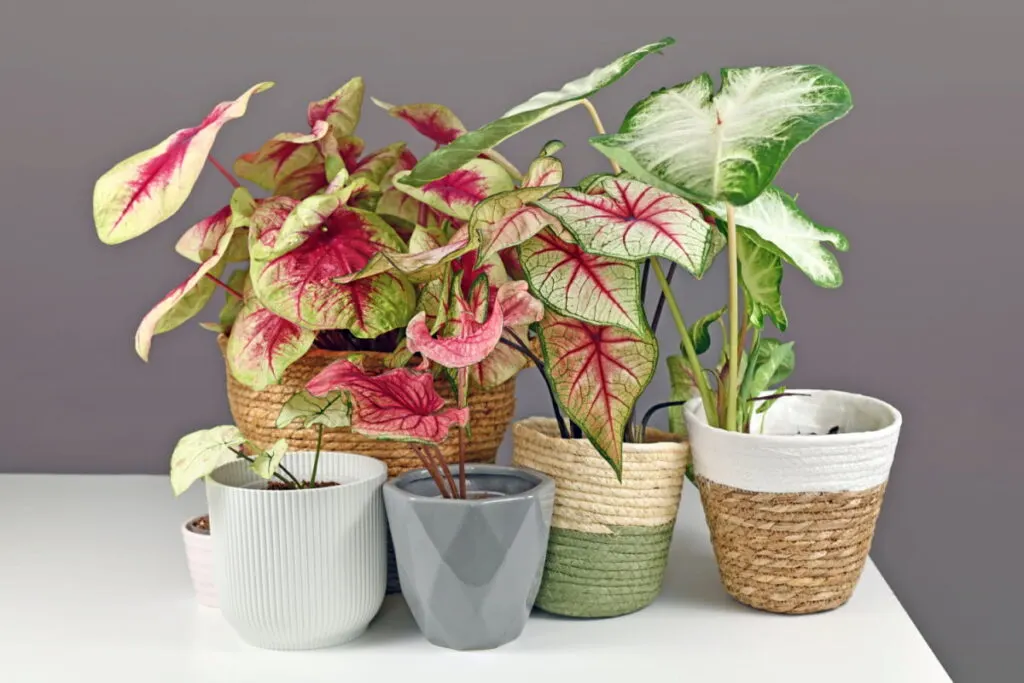
Tuberous Roots
Tuberous roots are distinct from other root types because their stored nutrients are located inside the root itself rather than an enlarged stem.
Dahlias grow from tuberous roots, and they multiply from buds at the top of the root or the base of the stem.
The tuberous root of a dahlia should be separated during planting time in the fall. The root should be cut into parts, leaving an eye with a stem on each part of the root.
Rhizomes
Unlike other roots, rhizomes grow horizontally under the soil’s surface.
Lily–of–the–valley is an example of a rhizome.
While growing horizontally, pips are formed that produce new plants.
Advantages of Planting Bulbs
The energy that flowering bulbs produce during one growing season may be stored for use during the next.
Bulbs have food reserves that produce new plant parts like roots, stems, leaves, and flowers after growth has begun.
Because of their independence, flower bulbs may be planted at any time, regardless of the weather or the state of the soil. The conditions for success are built into their very makeup.
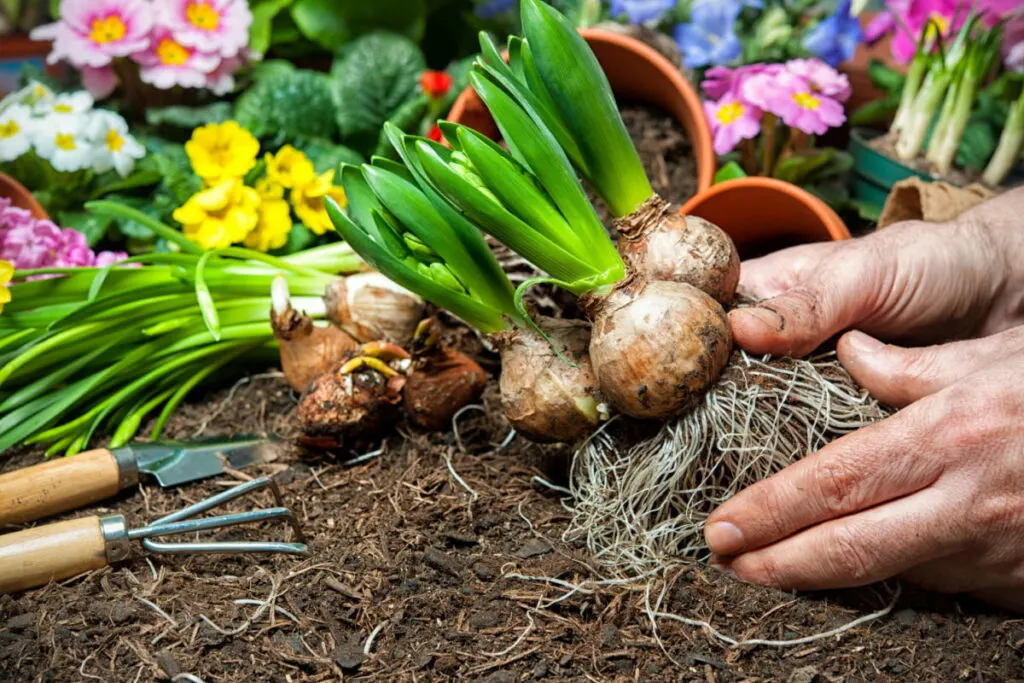
Bulbs Are Easy to Plant
Bulbs are compact, natural packages that are ready for planting without much effort.
Planting bulbs requires no specific expertise. Just dig a hole and insert the bulb!
Most bulbs are pretty versatile and will grow in places and conditions that other plants may not.
Bulbs are not fussy where you plant them.
Bulbs thrive in pots and containers, flower gardens, under trees and bushes, in forests, meadows, and even lawns. Simply plant the bulbs and wait for them to bloom.
When to Plant Bulbs
Bulbs come in different varieties, and each one blooms at different times of the year.
They should also be planted at specific times according to their type.
To grow spring–blooming flowers like tulips, daffodils, or alliums, you must plant the bulbs in the autumn so they will bloom the following spring.
For summer and fall blooms, bulbs like dahlias, calla lilies, and gladiolas should be planted in the spring.
Plant amaryllis and paperwhite bulbs in early January for midwinter interior blooms.
6 Bulbs That Bloom in Spring
Thanks to their various vibrant colors, bulbs that bloom in spring have a special place in our hearts. When the snow melts, the first bulbs begin to bloom.
And while most other plants await slightly warmer temperatures before they even think about awakening, bulb flowers pop up everywhere.
Spring blooming bulbs should be planted in mid to late fall.
After being planted, these bulbs will swiftly establish roots before hibernating until spring.
Here are six spring–blooming bulbs:
1. Snowdrops (Galanthus)
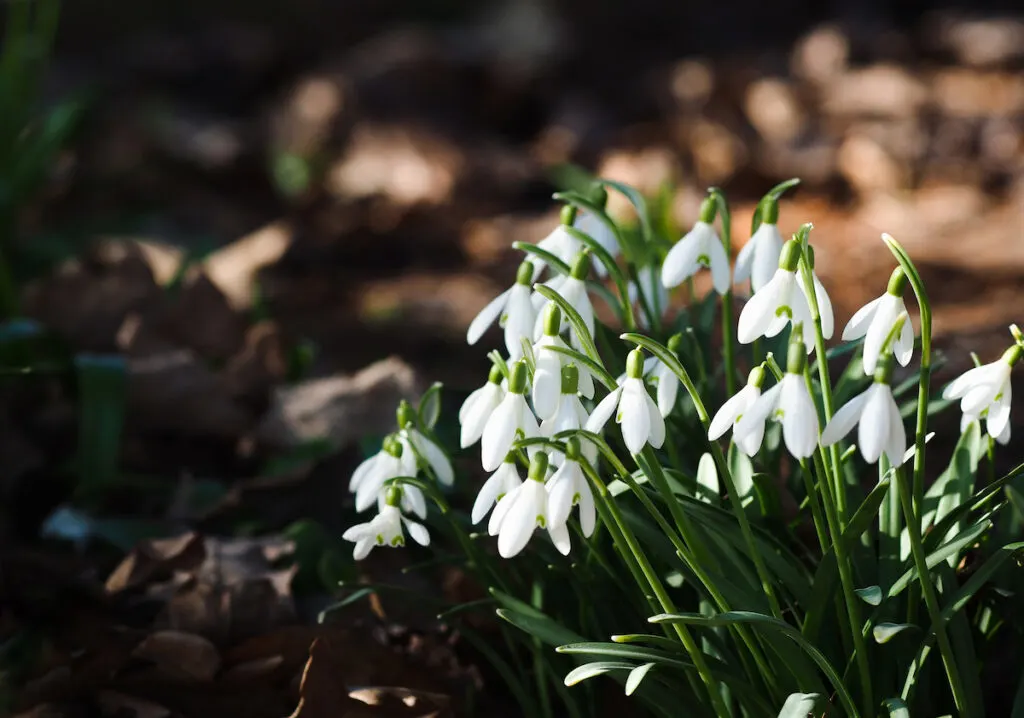
| Flower colors | Green, white |
| Blooming time | Late winter, early spring |
| Height | 8”–10” |
| Spread | 3”–6” |
| Spacing | 3” |
| Planting depth | 7” |
| Light | Full sun, partial sun |
| Maintenance | Low |
| Water needs | Average |
| Soil | Chalk, clay, loam, sand |
| Hardiness | 3 – 8 |
| Heat zone | 1 – 8 |
| Other | Self–seeding Grows into large colonies Poisonous to humans |
2. Dutch Crocus (Crocus vernus)
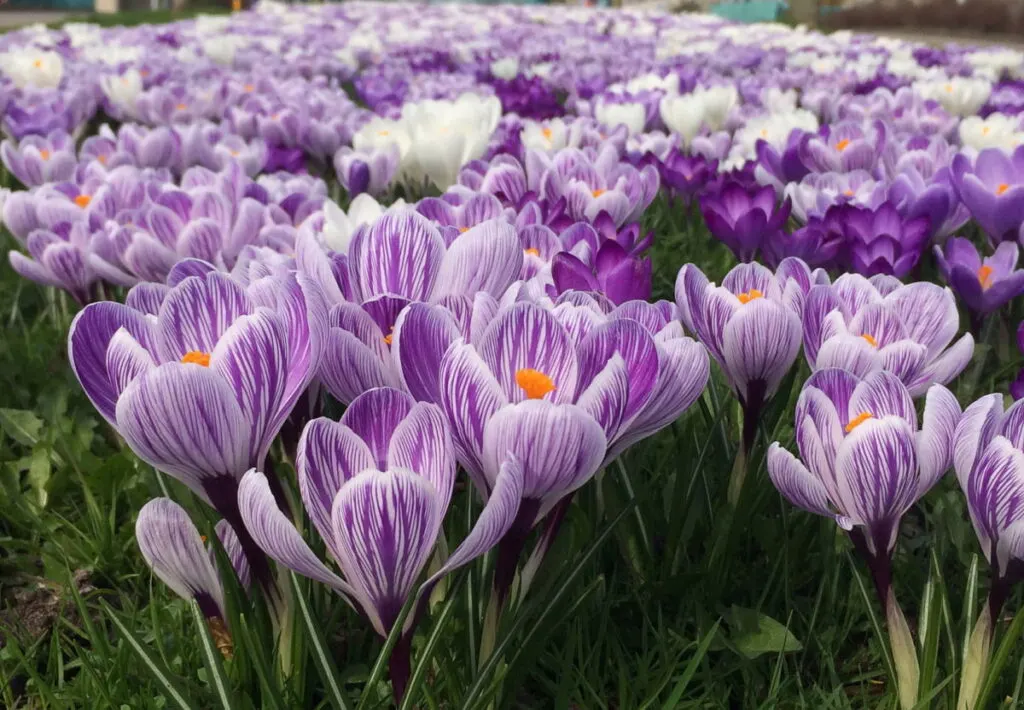
| Flower colors | Purple, lavender, yellow, white |
| Blooming time | Early spring |
| Height | 4”–6” |
| Spread | 2”–3” |
| Spacing | 3” |
| Planting depth | 4” |
| Light | Full sun, partial sun |
| Maintenance | Low |
| Water needs | Average |
| Soil | Chalk, clay, loam, sand |
| Hardiness | 3 – 8 |
| Heat zone | 1 – 8 |
| Other | Rodents often damage crocus bulbs. Squirrels are particularly skilled at finding, digging up, and eating newly planted crocus bulbs. |
3. Daffodils (Narcissus actaea)
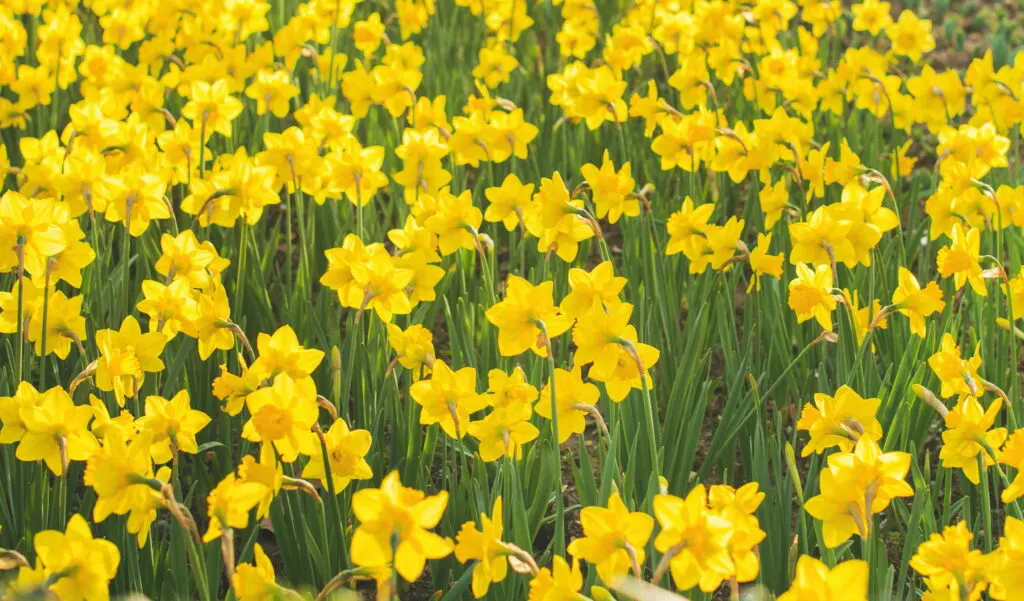
| Flower Colors | Yellow, orange, white, variegated |
| Blooming time | Mid to late spring |
| Height | 1’ – 2’ |
| Spread | 2”– 3” |
| Spacing | 3” |
| Planting depth | 7” |
| Light | Full sun, partial sun |
| Maintenance | Low |
| Water needs | Average |
| Soil | Chalk, clay, loam, sand |
| Hardiness | 3 – 9 |
| Heat zone | 1 – 9 |
| Other | Bulbs can be left in the ground for years. If the number of blooms and flower quality decline over time, dig up the clumps, split them, and replant them |
4. Siberian Squill (Scilla siberica)
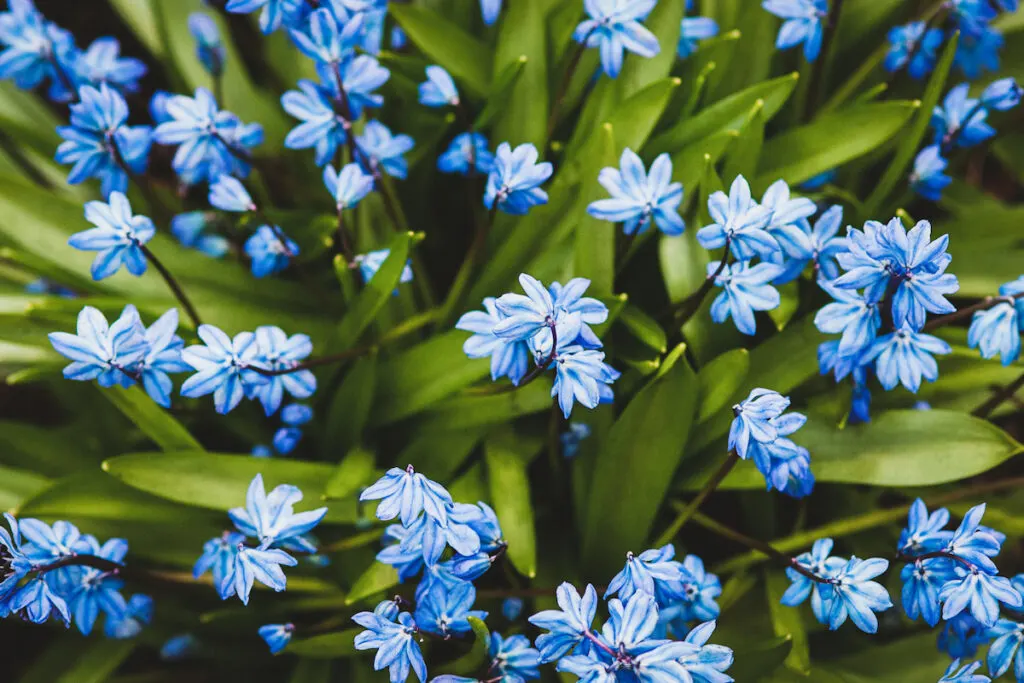
| Flower colors | Purple to blue |
| Blooming time | Early to mid spring |
| Height | 3”–6” |
| Spread | 3”–6” |
| Spacing | 2” |
| Planting depth | 4” |
| Light | Full sun, partial sun |
| Maintenance | Low |
| Water needs | Average |
| Soil | Chalk, loam, sand |
| Hardiness | 2 – 8 |
| Heat zone | 5 – 8 |
| Other | The plant is highly toxic for humans and animals. |
5. Tulip (Tulipa sp.)
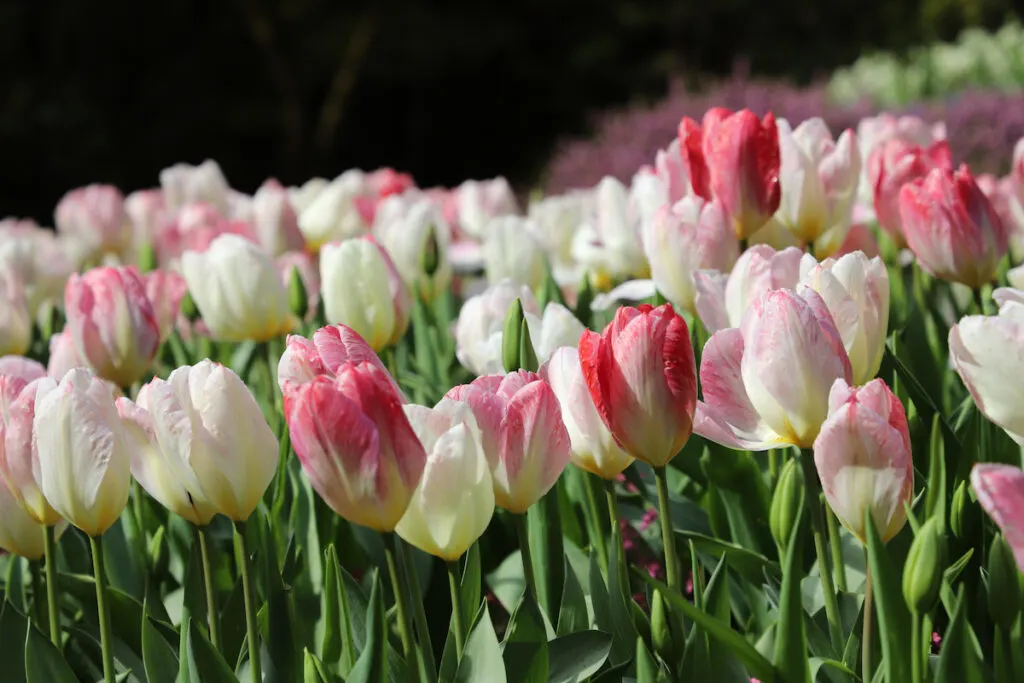
| Flower colors | Huge variety of colors, often multi–colored flowers |
| Blooming time | Early to mid spring |
| Height | 6” – 2’ |
| Spread | 6”– 1’ |
| Spacing | 6” – 1’ |
| Planting depth | 3” |
| Light | Full sun, partial sun |
| Maintenance | Low |
| Water needs | Average |
| Soil | Chalk, loam, sand |
| Hardiness | 3 – 8 |
| Heat zone | 1 – 8 |
| Other | Tulips may be grown as perennials or as annuals. The plant is intolerant to heat. Rodents often damage or eat tulip bulbs. |
6. Grape Hyacinth (Muscari sp.)
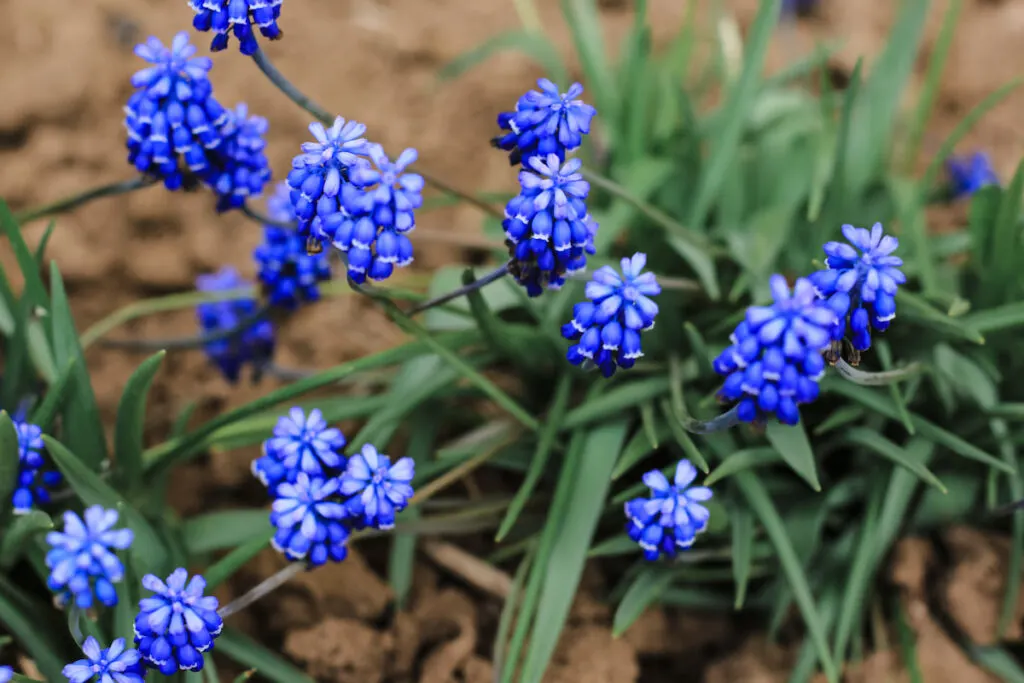
| Flower colors | Deep cobalt-blue, white, baby blue, blue, pink |
| Blooming time | Mid to late spring |
| Height | 4” – 8” |
| Spread | 1”– 2” |
| Spacing | 2” |
| Planting depth | 4” |
| Light | Full sun, partial sun |
| Maintenance | Low |
| Water needs | Average |
| Soil | Chalk, clay, loam, sand |
| Hardiness | 4 – 8 |
| Heat zone | 1 – 8 |
| Other | You should plant at least 25 bulbs close together for maximum effect. Muscari flowers can stay in bloom for up to one month. |
6 Bulbs That Bloom in Summer and Fall
Tropical plants like dahlias, canna lilies, and gladiolas are heat lovers and must be protected from frost. These bulbs should be planted in the spring after all ground frost has disappeared.
They will start to bloom during the summer months and continue doing so until the first signs of frost in the fall.
These bulbs will maintain the beauty of your garden or landscape even after most other flowers have faded.
Bulbs that bloom in the summer include:
- Bedding Dahlia (Dahlia)
- Ornamental Onion (Giant allium)
- Sword Lily (Gladiolus)
- Begonia (Tuberous Begonia)
- Meadow Saffron (Colchicum autumnale)
- Canna Lily (Canna)
1. Bedding Dahlia (Dahlia sp.)
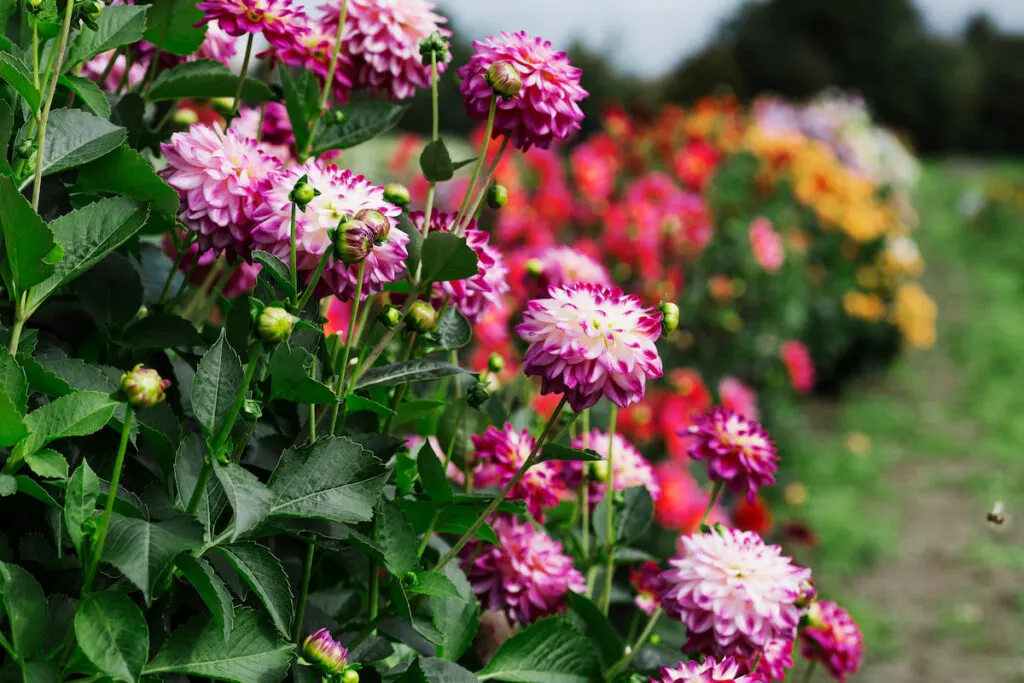
| Flower colors | Dahlias have roughly 40 recognized species and bloom in practically every color |
| Blooming time | Mid to late summer, fall |
| Height | Depends on the variety |
| Spread | 1’– 2’ |
| Spacing | 12” – 18” |
| Light | Full sun |
| Maintenance | Average |
| Water needs | Average |
| Soil | Chalk, loam, sand |
| Hardiness | 8 – 11 |
| Heat zone | 1 – 12 |
| Other | Temperatures below 25°F can damage Dahlias. Dahlias planted from tubers grow tall and may require support. |
2. Ornamental Onion (Allium giganteum)
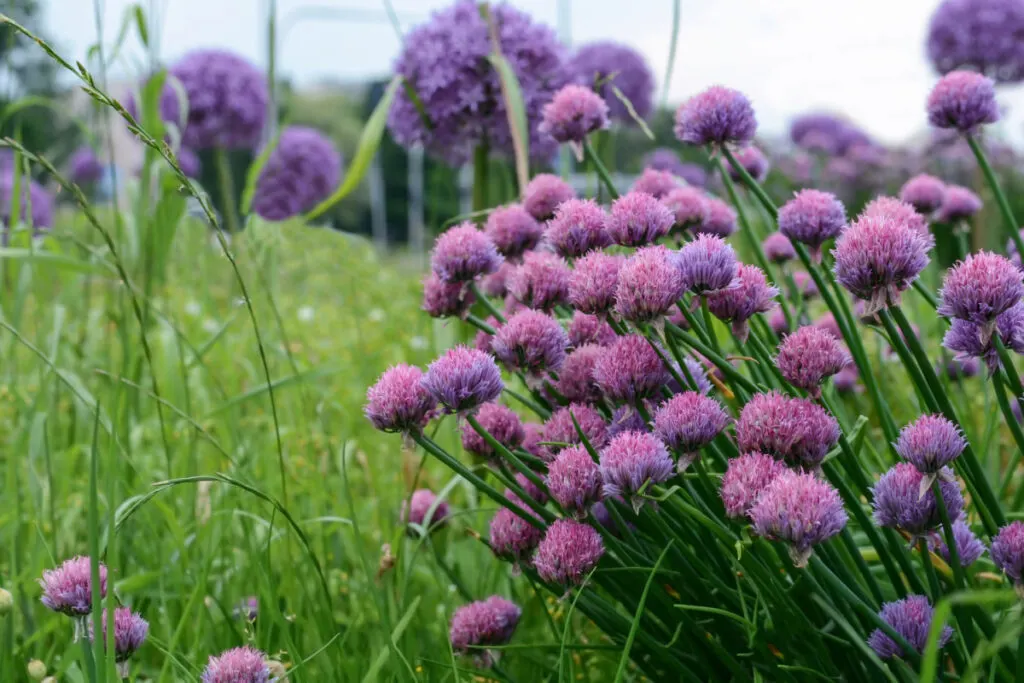
| Flower colors | Intense purple |
| Blooming time | Late spring, early summer |
| Height | 5’ – 6’ |
| Spread | 1’ – 2’ |
| Spacing | 8” |
| Planting depth | 8” |
| Light | Full sun |
| Maintenance | Low |
| Water needs | Average |
| Soil | Chalk, loam, sand, clay |
| Hardiness | 6 – 10 |
| Heat zone | 5 – 9 |
| Other | In the fall, mature bulbs can be dug up, split, and replanted to develop new plants. |
3. Sword Lily (Gladiolus)
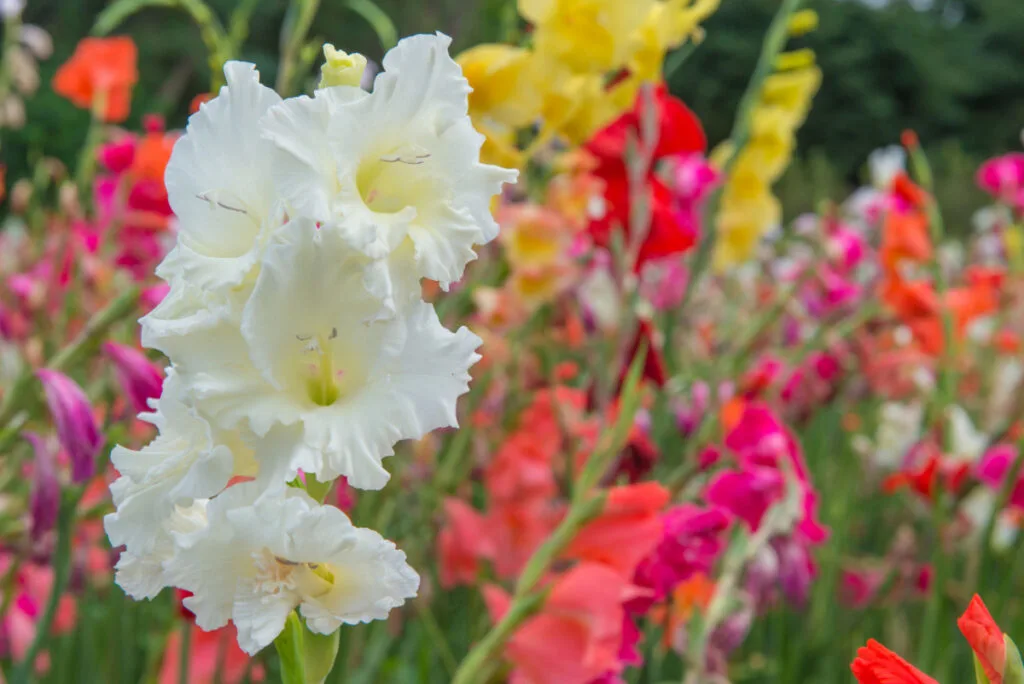
| Flower colors | There are more than 300 different species in the genus, and their flowers come in a wide spectrum of colors. |
| Blooming time | Early, mid or late summer depending on variety |
| Height | Depends on the variety |
| Spread | Depends on the variety |
| Spacing | 4”– 6” |
| Planting depth | 4” – 6” depending on variety |
| Light | Full sun |
| Maintenance | Low |
| Water needs | Average |
| Soil | Chalk, loam, sand |
| Hardiness | 8 – 11 |
| Heat zone | 1– 9 |
| Other | The flowers have a pleasant fragrance and make fantastic cut flowers. The bulbs can be dug up in the fall and planted again the following year. |
4. Begonia (Begonia tuberosa)
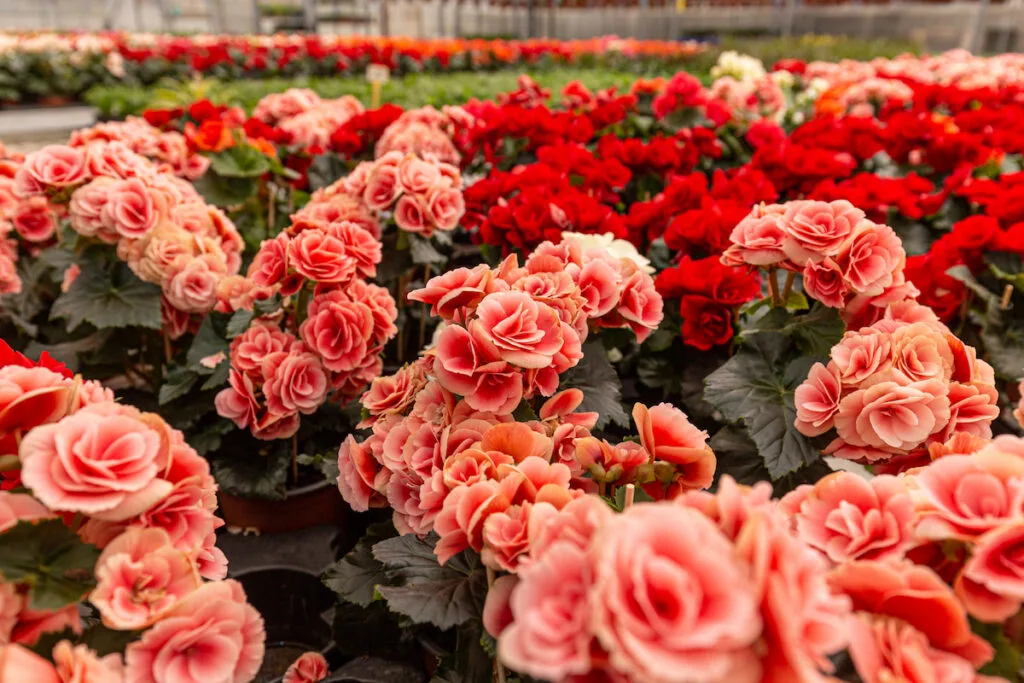
| Flower colors | Begonia tuberosa is a begonia hybrid that has 13 different flowering plants with multicolored petals. |
| Blooming time | Mid to late summer, fall |
| Height | Depends on the variety |
| Spread | Depends on the variety |
| Spacing | 12” |
| Planting depth | 1” |
| Light | Partial sun |
| Maintenance | Low |
| Water needs | Average |
| Soil | Loam, sand |
| Hardiness | 6 – 10 |
| Heat zone | 1 – 11 |
| Other | Some varieties might need to be staked. Keep the plant out of direct sunlight, and wind. Begonias grow easily from stem or leaf cuttings. |
5. Meadow Saffron, Fall Crocus (Colchicum autumnale)
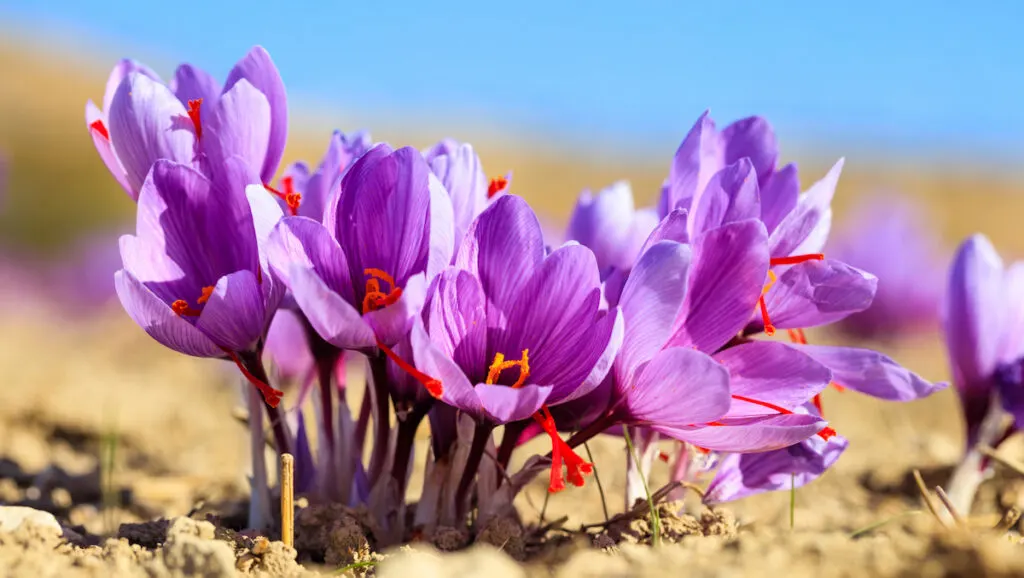
| Flower colors | Soft lilac |
| Blooming time | Fall |
| Height | 6”–8” |
| Spread | 6”–8” |
| Spacing | 8” |
| Planting depth | 8” |
| Light | Full sun, partial sun |
| Maintenance | Low |
| Water needs | Low, Average |
| Soil | Chalk, loam, sand, clay |
| Hardiness | 4 – 9 |
| Heat zone | 1 – 9 |
| Other | The plant is highly toxic. For fast expansion, split the plant every other year. |
6. Canna Lily (Canna sp.)
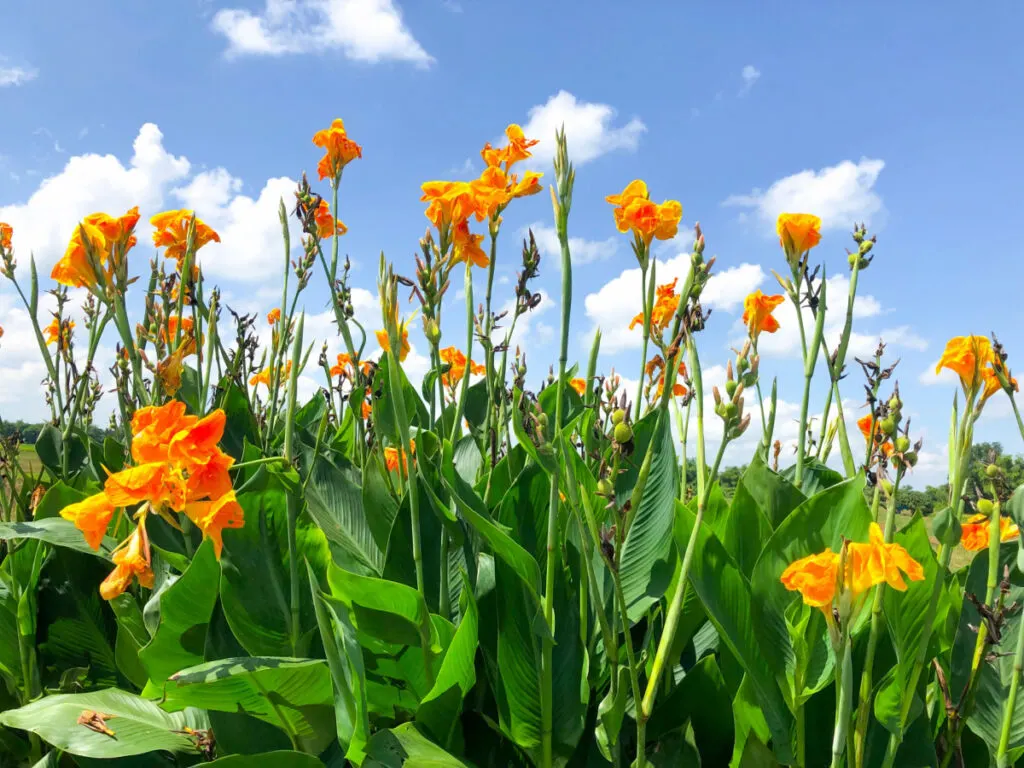
| Flower colors | Yellow, orange, different hues of pink, red, and cream |
| Blooming time | Mid to late summer, fall |
| Height | 4’ |
| Spread | 1’ – 2’ |
| Spacing | 18” – 24” |
| Planting depth | 8” |
| Light | Full sun |
| Maintenance | Average |
| Water needs | Average |
| Soil | Chalk, loam, sand, clay |
| Hardiness | 8 – 11 |
| Heat zone | 1 – 11 |
| Other | Good drainage is important for Canna lily. Hummingbirds are attracted to Canna plants with red blooms. |
Final Thoughts
Wherever you’re from, there is no denying that the first blooms of spring breathe new life into our lives.
Flowers that bloom from underground bulbs remind us that the natural world is awakening, the days are getting longer, and the cold and frost will soon be behind us.
Bulbs are easy to plant, don’t need much maintenance, and will bloom in conditions that are not ideal for other plants.
For spring blooms, plant in the fall, and for summer and fall blooms, plant in the spring.
From spring through fall, blossoming bulbs will brighten up even the dullest landscape or garden, adding fragrance and beauty.
Resources
- https://plants.ces.ncsu.edu/plants/narcissus/
- https://gardenbeast.com/bulb–flowers/
- https://web.extension.illinois.edu/bulbs/bulbbasics.cfm
- https://www.rhs.org.uk/plants/snowdrops
- https://www.longfield–gardens.com/article/Easy–to–grow–bulbs#:~:text=Flowering
- https://www.easytogrowbulbs.com/blogs/articles–and–tips/best–early–spring–blooming–bulbs
- https://plants.ces.ncsu.edu/plants/galanthus–nivalis/
- https://www.gardenia.net/plant/galanthus–atkinsii–snowdrop
- https://plants.ces.ncsu.edu/plants/crocus/
- https://www.gardenia.net/plant/crocus–vernus–grand–maitre
- https://www.gardenia.net/plant/narcissus–actaea–poeticus–daffodil
- https://plants.ces.ncsu.edu/plants/narcissus/
- https://plants.ces.ncsu.edu/plants/scilla–siberica/
- https://www.gardenia.net/plant/scilla–siberica–siberian–squill
- https://www.gardenia.net/plant/botanical–tulips–open–early–are–close–to–the–ground–and–flower–beautifully
- https://plants.ces.ncsu.edu/plants/tulipa/
- https://plants.ces.ncsu.edu/plants/dahlia/common–name/dahlia/
- https://www.gardenia.net/plant/dahlia–gallery–rembrandt
- https://www.gardenia.net/plant/dahlia-gallery-monet
- https://www.gardenia.net/plant/allium-giganteum-ornamental-onion
- https://plants.ces.ncsu.edu/plants/gladiolus/
- https://www.gardenia.net/plant/gladiolus-invitatie
- https://www.gardenia.net/plant/gladiolus-night-mare
- https://plants.ces.ncsu.edu/plants/begonia-tuberosa-group/
- https://www.gardenia.net/plant/begonia-picotee-lace-red
- https://www.gardenia.net/plant/colchicum-byzantinum-meadow-saffron
- https://plants.ces.ncsu.edu/plants/colchicum-autumnale/common-name/meadow-saffron/
- https://plants.ces.ncsu.edu/plants/canna/common-name/canna-lily/
- https://www.gardenia.net/plant/canna-cannova-yellow
- https://www.gardenia.net/plant/canna-city-of-portland-canna-lily
- https://plants.ces.ncsu.edu/plants/leopoldia-comosa-plumosum/common-name/grape-hyacinth/
- https://www.gardenia.net/plant-variety/muscari-grape-hyacinth
- https://www.gardenia.net/plant/muscari-aucheri-blue-magic-grape-hyacinth
